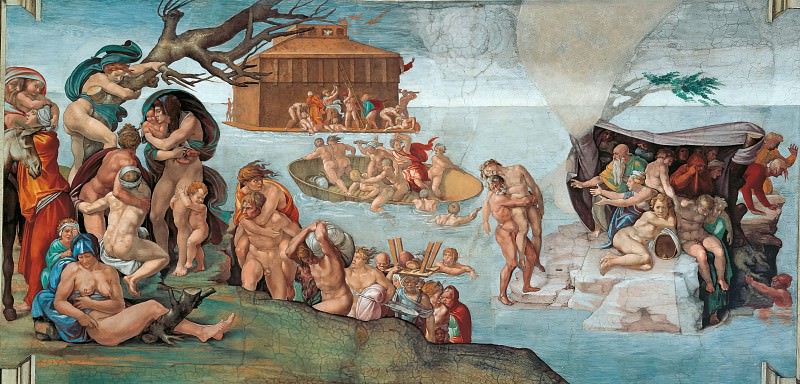The Flood Michelangelo Buonarroti (1475-1564)
Michelangelo Buonarroti – The Flood
Edit attribution
Download full size: 4620×2212 px (3,1 Mb)
Painter: Michelangelo Buonarroti
Location: Vatican Museums (fresco) (Musei Vaticani (murales)), Vatican.
"The Flood" is the very fresco with which Michelangelo Buonarrotti began painting the Sistine Chapel. At first, the Italian master was unsure of his abilities and even employed skilled frescoists from Florence. But time passed, and now Buanarotti, being dissatisfied with the work of his assistants, sends them back and continues to paint the walls himself. As in all his works, Michelangelo explores in The Flood human nature, his actions under the influence of misfortune, disasters, catastrophes, the reaction to what is happening around him.
Description of Michelangelo Buonarroti’s painting The Flood
"The Flood" is the very fresco with which Michelangelo Buonarrotti began painting the Sistine Chapel. At first, the Italian master was unsure of his abilities and even employed skilled frescoists from Florence.
But time passed, and now Buanarotti, being dissatisfied with the work of his assistants, sends them back and continues to paint the walls himself. As in all his works, Michelangelo explores in The Flood human nature, his actions under the influence of misfortune, disasters, catastrophes, the reaction to what is happening around him. Several individual fragments add up to a whole fresco where the real tragedy unfolds. In the foreground, a group of people try to escape on a tiny piece of land, huddled together like a herd of frightened sheep.
A man tries to postpone impending doom for himself and his beloved by lifting her onto his back. The child hides in despair behind the body of his mother, who seems to have surrendered to Fate. The young man crawls along the trunk of a tree, hoping to escape death. On the right, another group takes refuge in a piece of canvas in a vain attempt to hide from the torrent of water pouring down from the sky.
A small boat sways on the restless waves, where there is a struggle for space between the distraught sufferers. And in the distance floats the Ark, with several people pounding at its walls, furiously seeking to be allowed inside and rescued from the approaching water.
The characters in the fresco behave in different ways: some cling to the last chance, climbing literally on the backs of others, some stretch out their hands to help, some are willing to throw their neighbor to the elements, in order to stretch out the extra seconds. But the only question that worries everyone, who in a moment will disappear under the water - why do they have to die and for what? But the sky is silent, and only continuous streams of water pour down on the unhappy earth.
Кому понравилось
Пожалуйста, подождите
На эту операцию может потребоваться несколько секунд.
Информация появится в новом окне,
если открытие новых окон не запрещено в настройках вашего браузера.
You need to login
Для работы с коллекциями – пожалуйста, войдите в аккаунт (open in new window).




















You cannot comment Why?
This painting depicts the biblical story of the Great Flood, a catastrophic event where God cleansed the Earth of wickedness by unleashing a massive deluge.
What I see:
The artwork is filled with numerous naked human figures struggling in a vast expanse of water. In the distance, Noahs Ark, a large wooden structure, is visible, with figures attempting to board it or clinging to its sides. A small boat filled with people navigates the turbulent waters near the ark. On the far left, a gnarled tree trunk rises precariously, with figures desperately clinging to it.
On the right side of the painting, a rocky outcrop emerges from the water, serving as a refuge for a cluster of people. Some are depicted looking out at the flood with expressions of despair or shock, while others are huddled together, seeking comfort and protection. The water itself is rendered in various shades of blue and green, conveying its immense power and destructive force. Theres a sense of chaos and desperation throughout the scene, with bodies intertwined in their struggle for survival.
Subtexts:
The Flood is a powerful depiction of divine judgment and the consequences of human sin. The overwhelming presence of water symbolizes purification and destruction. The varied emotional states of the figures – fear, desperation, grief, and even a sense of resignation – reflect the immense tragedy of the event.
The inclusion of a variety of human forms and interactions can be interpreted in several ways. The vulnerability of the naked figures emphasizes their human frailty in the face of divine power. The desperate embraces and clustered groups suggest the primal human drive for connection and survival in times of crisis.
The stark contrast between the ark, representing salvation and divine intervention, and the vast majority of humanity struggling against the flood, highlights themes of faith, obedience, and the selective nature of divine mercy. The overwhelming nature of the flood serves as a visual representation of the magnitude of sin and the absolute power of God.